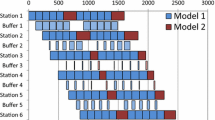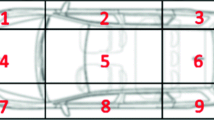Abstract
The production line considered in this paper is a U-shaped, mixed-model, asynchronous line where assembly and fabrication tasks are performed to produce a variety of different discrete products or models in a just-in-time (JIT) environment. Two important problems occur routinely with these lines. The first is the assignment of tasks to stations on the line—the line balancing problem—and the second is the selection of the sequence in which models will be produced—the model sequencing problem. The model sequence cannot be set independently of the line balance, because different models require different tasks and the same tasks have different completion times for different models, and, in the JIT environment, the model sequence cannot be set independently of the schedules of other lines and production facilities. JIT uses a pull rather than a push system of production control, which means that the model sequence at the U-shaped mixed-model final assembly line sets the schedules at the other production facilities. JIT requires these latter schedules to be “level” and this requirement imposes an additional constraint on the model sequence. The effect of these two conditions is to require that the line-balancing and model-sequencing problems be solved simultaneously. In this article, we model the joint problem and present a solution algorithm for solving instances of practical size.
Similar content being viewed by others
References
Bard, J. F., Dar-El, E., and Shtub, A., “An Analytic Framework for Sequencing Mixed-Model Assembly Lines,” International Journal of Production Research, Vol. 30, pp. 35–48 (1992).
Baybars, I., “A Survey of Exact Algorithms for the Simple Assembly Line Balancing Problem,” Management Science, Vol. 32, No.8, pp. 909–932 (1986).
Cross, K., “Wang Scores EPIC Success with Circuit Board Assembly Redesign,” Industrial Engineering, pp. 52–56 (January 1988).
Ghosh, S. and Gagnon, R. J., “A Comprehensive Literature Review and Analysis of the Design, Balancing and Scheduling of Asssembly Systems,” International Journal of Production Research, Vol. 27, No.4, pp. 637–670 (1989).
Gryga, J., “Material Handling: Key to Assembly at Allen-Bradley,” Materials Handling Engineering, Vol. 50, No.13, pp. 34–38 (December 1995).
Hackman, S. T., Magazine, M. J., and Wee, T. S., “Fast, Effective Algorithms for Simple Assembly Line Balancing Problems,” Operations Research, Vol. 37, No.6, pp. 916–924 (1989).
Hall, R. W., Zero Inventories, Dow Jones-Irwin, Homewood, IL (1983).
Hoffmann, T. R., “Eureka: A Hybrid System for Assembly Line Balancing,” Management Science, Vol. 38, No.1, pp. 39–47 (1992).
Johnson, R. V., “Optimally Balancing Large Assembly Lines with Fable,” Management Science, Vol. 34, No.1, pp. 240–253 (1988).
Kim, Y.K., Kim,Y. J., and Kim,Y. H., “Genetic Algorithms for Assembly Line Balancing withVarious Objectives,” Computers and Industrial Engineering, Vol. 30, No.3, pp. 397–409 (1996).
Kubiak, W., “Minimizing Variation of Production Rates in Just-in-Time Systems: A Survey,” European Journal of Operational Research, Vol. 66, pp. 259–271 (1993).
Macaskill, J. L., “Production Line Balances for Mixed-Model Lines,” Management Science, Vol. 19, No.4, pp. 423–433 (1972).
Miltenburg, J., “U-Shaped Production Lines: A Review of Theory and Practice,” International Journal of Production Economics, Vol. 70, pp. 201–214 (2001).
Miltenburg, J., “Balancing U-lines in a Multiple U-line Facility,” European Journal of Operational Research, Vol. 109, No.1, pp. 1–23 (1998).
Miltenburg, J. and Goldstein, T., “Developing Production Schedules that Balance Part Usage and Smooth Production Loads for Just-in-Time Production Systems,” Naval Research Logistics, Vol. 38, pp. 893–910 (1991).
Miltenburg, J. and Wijngaard, J., “The U-line Balancing Problem,” Management Science, Vol. 40, No.10, pp. 1378–1388 (1994).
Mitchell, M., An Introduction to Genetic Algorithms, Bradford Book, The MIT Press, Cambridge, MA (1996).
Monden, Y., Toyota Production System, 2nd. ed., Industrial Engineering Press, Institute of Industrial Engineers, Norcross, GA (1993).
Nikkan Kogyo Shimbun, The Factory Management Notebook Series: Mixed-Model Production, Productivity Press, Portland, OR (1991).
Sekine, K., One-Piece Flow, Productivity Press, Portland, OR (1992).
Schroeder, R. G., Operations Management: Contemporary Concepts and Cases, Irwin/McGraw-Hill, New York, NY (2000).
Schmitt, L. J. and Amini, M. M., “Performance Characteristics of Alternative Genetic Algorithmic Approaches to the Travelling Salesman Problem using Path Representation: An Empirical Study,” European Journal of Operational Research, Vol. 108, pp. 551–570 (1998).
Sparling, D., “Balancing Just-in-Time Production Units: The N U-line Balancing Problem,” INFOR, Vol. 36, No.4, pp. 215–237 (1998).
Talbot, F. B., Patterson, J., and Gehrlein, W., “A Comparative Evaluation of Heuristic Line Balancing Techniques,” Management Science, Vol. 32, No.4, pp. 430–454 (1986).
Thomopolous, N. T., “Mixed Model Line Balancing with Smoothed Station Assignments,” Management Science, Vol. 16, No.9, pp. 593–603 (1970).
Urban, T., “Note: Optimal Balancing of U-shaped Assembly Lines,” Management Science, Vol. 44, No.5, pp. 738–741 (1998).
Yano, C. A. and Rachamadugu, R., “Sequencing to Minimize Work Overload in Assembly Lines with Product Options,” Management Science, Vol. 37, No.5, pp. 572–586 (1991).
Author information
Authors and Affiliations
Rights and permissions
About this article
Cite this article
Miltenburg, J. Balancing and Scheduling Mixed-Model U-Shaped Production Lines. International Journal of Flexible Manufacturing Systems 14, 119–151 (2002). https://doi.org/10.1023/A:1014434117888
Issue Date:
DOI: https://doi.org/10.1023/A:1014434117888




